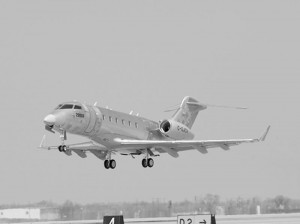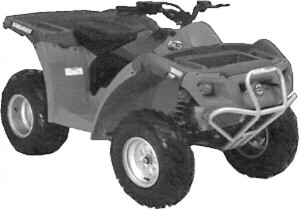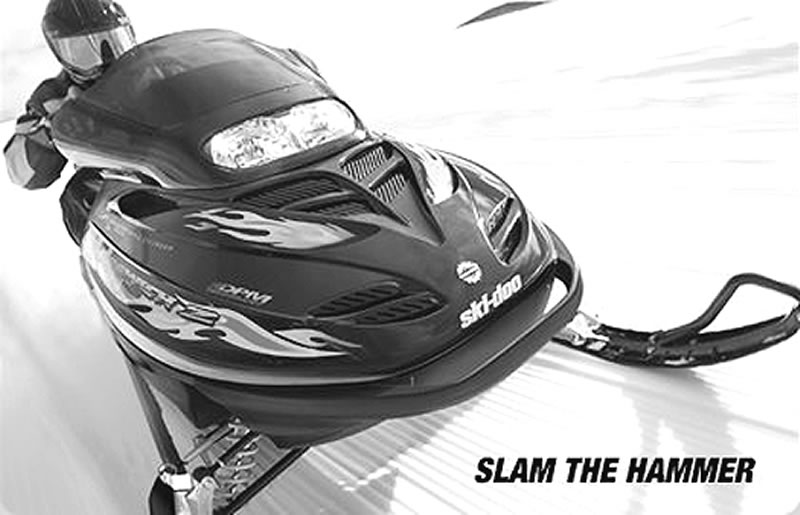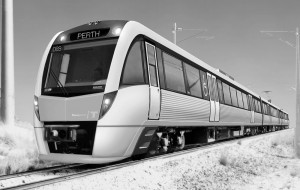By Di Freeze
If you think Bombardier just makes aircraft, think again.
Joseph-Armand Bombardier was born at Valcourt, east of Montréal near Sherbrooke, Québec, Canada, on April 16, 1907. The son of a prosperous farmer, he grew up accustomed to severe winters and isolation caused by roads that could not be traversed.
When his father presented him with a Model T Ford, Bombardier, 15, promptly removed the motor and attached it to the framework of a typical four-passenger sleigh. He then installed an aircraft propeller on the drive shaft behind the transmission, added four sleigh runners, and proudly drove the contraption through the main street of his hometown village.
Experimentation continued over the years. By 1937, the year he was granted his first patent, he had introduced his principle of steering by skis in front of a tracked drive.
|
In 1942, Bombardier founded L’Auto-Neige Bombardier Limitée to manufacture tracked vehicles for transportation on snow-covered terrain. Bombardier’s inventions included the Muskeg, an all-purpose vehicle with eight wheels and two tracks on each side, used primarily for oil exploration in Canada’s northwest. During the winter of 1959, he perfected a light, reliable, and soon to be extremely popular snow vehicle called the Ski-Doo. Joseph-Armand Bombardier, known as the “Father of Snowmobiling,” died at Sherbrooke, Quebec, on Feb. 18, 1964. Laurent Beaudoin, Bombardier’s son-in-law, joined Bombardier Limitée in 1963, and was appointed general manager in 1964. He became president in 1966. The following year, L’Auto-Neige Bombardier Limitée became Bombardier Limited. On January 23, 1969, two million shares of Bombardier stock were listed on the Montréal and Toronto stock exchanges (shares are now traded on the Toronto, Brussels and Frankfurt stock exchanges). |

The fourth Bombardier Continental Business Jet (serial number 20004) successfully completed its first flight in April 2002.
Through the years, Bombardier has become a diversified global corporation, currently leading the business jet and regional aircraft markets worldwide as well as being the global leader in passenger railcar manufacturing. It is also recognized as the benchmark for the introduction of innovative recreational products. Still headquartered in Montréal, Québec, the corporation has a workforce of about 80,000 people in 24 countries throughout the Americas, Europe and Asia-Pacific.
In the early 1970s, Bombardier acquired the Austrian company Lohnerwerke GmbH (now Bombardier-Wien Schienenfahrzeuge AG), and subsidiary Rotax-Werk AG (now Bombardier-Rotax GmbH), the supplier of the Rotax engine used in Bombardier’s snowmobiles.
In 1972, subsidiaries Bombardier Credit Ltd., in Canada, and Bombardier Credit Inc. (now Bombardier Capital Inc.), in the United States, were created to handle inventory financing of Ski-Doo dealers.
Following the 1973 energy crisis, which precipitated a decline in the snowmobile market, Bombardier diversified into the transit equipment industry, with the company’s contract to build rolling stock for the City of Montreal subway system.
It wasn’t until December 1986, that Bombardier entered the aircraft arena, with its acquisition of Canadair, Canada’s leading aircraft manufacturer.

In February 2002, Bombardier Recreational Products launched the entry-level Rally 200 all-terrain vehicle, a full-size, value-priced ATV.
Other acquisitions followed, including the 1989 acquisitions of the assets and operations of the tracked vehicle division of Universal Go-Tract, in the U.S.; Short Brothers plc (Shorts), a Northern Ireland manufacturer of civil and military aircraft, aerostructures and defense systems; and ANF-Industrie, France’s second largest manufacturer of railway equipment.
1990 saw the creation of subsidiaries Bombardier Real Estate Ltd., responsible for the management of Bombardier’s real estate assets (this activity now comes under Bombardier Inc., Real Estate Services), and Learjet Inc., established to acquire the assets and operations of the Learjet Corporation.
Acquisitions in the 1990s included the purchase of the 49 percent interest in de Havilland, owned by the Province of Ontario, and Learjet Inc.’s acquisition of four aircraft maintenance centers from AMR Combs. 1995 saw a joint venture between Bombardier and AMR Combs, as Business JetSolutions. Offering Flexjet, a fractional ownership program, in December 1997, Bombardier acquired AMR Combs’ interest in the program.
In April 1996, Bombardier was reorganized into five groups—Bombardier Aerospace, Bombardier Transportation, Bombardier Recreational Products, Bombardier Services and Bombardier Capital. Bombardier International was created in 1998 to pursue opportunities for Bombardier into targeted markets outside of North America and Western Europe.
Presently the third largest civil aircraft manufacturer worldwide, Bombardier Aerospace now offers complete families of turboprop and regional jet aircraft, and has the industry’s widest range of business jets, including Learjet, Challenger, Global Express and Continental, offered both in full and fractional ownership. Bombardier holds a strong position in the widebody market in Europe, accounting for 34 percent of deliveries from 1997 to April 2002.
Bombardier Aerospace is under the leadership of President and Chief Operating Officer Pierre Beaudoin, the son of Bombardier Inc. Chairman Laurent Beaudoin, and grandson of Joseph-Armand Bombardier. (Laurent Beaudoin became chairman and CEO of Bombardier, Inc., in 1979. On Feb. 1, 1999, he became chairman of the board and of the executive committee.)
This month alone, Bombardier Aerospace celebrated $58 million in new business jet sales, while Bombardier Transportation, with products including passenger rail cars and complete rail transportation systems, announced several contracts. Those contracts include a joint venture with Australian train manufacturer EDI-Rail, to build 31 three-car electric commuter trains for the southern leg of the Perth Urban Rail Development project. As a partnership in the Metronet Consortium, Bombardier has landed major supply and maintenance contracts on work the consortium is doing on London’s underground rail system over the next 30 years. Bombardier’s railcars are already in use in subways around the world, but the London contracts will be the largest in the company’s history. Also in May, Bombardier Transportation was simultaneously awarded orders for rail transportation equipment in the U.S. and in Italy.
Acquisitions continue, such as the 2001 purchase of Outboard Marine Corporation’s engine assets and DaimlerChrysler Rail Systems GmbH (Adtranz), based in Berlin, Germany.
Bombardier has remained active in the field of recreational products. Bombardier Recreational Products continues to design, develop, build, distribute and market Ski-Doo and Lynx snowmobiles, snow grooming equipment and multi-purpose tracked vehicles, as well as Sea-Doo watercraft and sport boats, Bombardier Fish Hawk fishing boats and Evinrude and Johnson outboard marine engines.
In February, the division launched the entry-level Rally 200 all-terrain vehicle, which joins Bombardier’s utility-targeted Traxter ATV, the DS650TM ATV sport models, the sport-utility Quest and their youth-oriented ATVs. The Rally 200 is a full-size, value-priced ATV combining elements of existing Bombardier models; it is the only ATV in its class with a continuously variable transmission (CVT).













